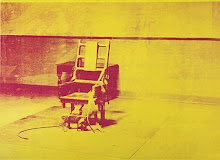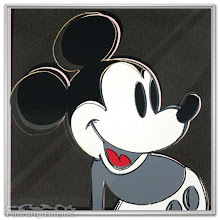Summary: Born and raised in Pittsburg, Andy Warhol was the son of Slovakian immigrants. Around the age of thirteen, Warhol tragically lost his father in a construction accident. After showing early signs of talent in drawing and painting, he then went on to graduate with a commercial art degree. After school he began work for
Harpar’s Bazaar and
Vogue, establishing himself in the art world. Once Warhol broke free of the commercial world, he held his first individual exhibition in 1952 at the Hugo Gallery in New York. Then in 1956 he had another exhibition at the Museum of Modern Art. In the sixties he began painting everyday mass/consumer products such as the coke bottle and Campbell’s soup can. Then in 1962 he began silk screening famous people such as Monroe. Not only did he recreate images of mass production products but he also wanted to mass produce his works. To accomplish this he created his studios know as the Factory. It was not only his art studio but also a film studio for Warhol’s next move. In July of 1968, Warhol was shot which nearly cost him his life. After this attempt to take his life, Warhol had a radical change in his career where he now focused on individual portraits of well know people. A little into Warhol as a person: he was gay and loved cats. He was a workaholic and was determined to become rich and famous. Tragically he died in 1987.
Response: Like some of my other sources, this article focused on Warhol’s career through stages in his art. Fortunately it was much easier to read than most of the other sources. I think that is due to the way the site is broken down in chunks of information rather than a straight essay type work. However, this author portrayed Warhol’s personality as one who was all about fame and fortune and before it seemed as if he was genuine person. I also liked that the author chose to throw in quotes to express their point. One thing the author said about Warhol’s videos was that they were, “rather bizarre and some rather pornographic.” I never got that from any other site and truly do not want to believe that! However, I’m not going to sort through all his crazy films to find out.
Wanczura, Dieter. "Andy Warhol-1928-1987." Artelino. Mar 2009. 8 Apr 2009.
.


















